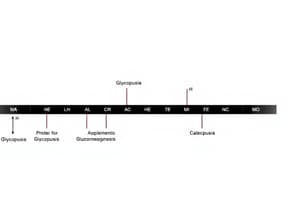Podcast
Questions and Answers
What is the primary location of glycolysis in the cell?
What is the primary location of glycolysis in the cell?
- Cytoplasm (correct)
- Mitochondria
- Nucleus
- Endoplasmic reticulum
Which enzyme is responsible for converting fructose-6-phosphate to fructose-1,6-bisphosphate in glycolysis?
Which enzyme is responsible for converting fructose-6-phosphate to fructose-1,6-bisphosphate in glycolysis?
- Pyruvate kinase
- Phosphofructokinase (correct)
- Glycogen phosphorylase
- Hexokinase
Which of the following is a key precursor for gluconeogenesis?
Which of the following is a key precursor for gluconeogenesis?
- Fatty acids
- Fructose
- Glucose
- Lactate (correct)
What is the main result of glycogenolysis?
What is the main result of glycogenolysis?
Which process is primarily activated by glucagon?
Which process is primarily activated by glucagon?
What does the Pentose Phosphate Pathway primarily produce?
What does the Pentose Phosphate Pathway primarily produce?
Which enzyme is involved in the first step of gluconeogenesis converting pyruvate to oxaloacetate?
Which enzyme is involved in the first step of gluconeogenesis converting pyruvate to oxaloacetate?
How does insulin affect blood glucose levels?
How does insulin affect blood glucose levels?
Which of the following enzymes is associated with the regulation of the Pentose Phosphate Pathway?
Which of the following enzymes is associated with the regulation of the Pentose Phosphate Pathway?
What substance inhibits gluconeogenesis?
What substance inhibits gluconeogenesis?
Flashcards are hidden until you start studying
Study Notes
Carbohydrate Metabolism
Glycolysis
- Definition: The process of breaking down glucose into pyruvate, producing energy.
- Location: Cytoplasm of the cell.
- Phases:
- Energy Investment Phase: Consumes 2 ATP to phosphorylate glucose and its intermediates.
- Energy Payoff Phase: Produces 4 ATP, 2 NADH, and 2 pyruvate; net gain of 2 ATP.
- Key Enzymes:
- Hexokinase (glucose → glucose-6-phosphate)
- Phosphofructokinase (PFK) (fructose-6-phosphate → fructose-1,6-bisphosphate)
- Pyruvate kinase (phosphoenolpyruvate → pyruvate)
Gluconeogenesis
- Definition: The synthesis of glucose from non-carbohydrate precursors.
- Location: Primarily in the liver and kidneys.
- Key Precursors: Lactate, glycerol, and amino acids (especially alanine).
- Key Enzymes:
- Pyruvate carboxylase (pyruvate → oxaloacetate)
- Phosphoenolpyruvate carboxykinase (oxaloacetate → phosphoenolpyruvate)
- Fructose-1,6-bisphosphatase (fructose-1,6-bisphosphate → fructose-6-phosphate)
- Regulation: Stimulated by cortisol and glucagon; inhibited by insulin.
Glycogenolysis
- Definition: The breakdown of glycogen into glucose-1-phosphate and glucose.
- Location: Liver and muscle cells.
- Key Steps:
- Glycogen phosphorylase cleaves glycogen to release glucose-1-phosphate.
- Debranching enzyme is involved in removing branches of glycogen.
- Regulation: Activated by glucagon and epinephrine; inhibited by insulin.
Pentose Phosphate Pathway (PPP)
- Definition: A metabolic pathway parallel to glycolysis that generates NADPH and ribose-5-phosphate.
- Location: Cytoplasm.
- Functions:
- Produces NADPH for reductive biosynthesis and antioxidant defense.
- Provides ribose-5-phosphate for nucleotide synthesis.
- Key Enzymes:
- Glucose-6-phosphate dehydrogenase (G6PD) (glucose-6-phosphate → 6-phosphoglucono-δ-lactone)
- Transaldolase and transketolase (involved in sugar rearrangement)
- Regulation: Activated by NADP+; inhibited by NADPH.
Insulin and Glucose Regulation
- Role of Insulin:
- Secreted by beta cells of the pancreas in response to high blood glucose levels.
- Promotes glucose uptake by cells, especially muscle and adipose tissues.
- Stimulates glycogenesis (conversion of glucose to glycogen) and inhibits glycogenolysis and gluconeogenesis.
- Key Effects:
- Lowering blood glucose levels.
- Enhancing storage of lipids and proteins.
- Counter-Regulatory Hormones:
- Glucagon: Raises blood glucose by stimulating glycogenolysis and gluconeogenesis.
- Epinephrine: Increases blood glucose levels during stress or fight-or-flight response.
- Feedback Mechanism: Blood glucose levels are tightly regulated by the balance between insulin and counter-regulatory hormones.
Glycolysis
- Breaks down glucose into pyruvate, yielding energy.
- Occurs in the cytoplasm of cells.
- Phases:
- Energy Investment Phase: Requires 2 ATP for phosphorylation reactions.
- Energy Payoff Phase: Produces 4 ATP, 2 NADH, and 2 pyruvate; results in a net gain of 2 ATP.
- Key Enzymes:
- Hexokinase: Catalyzes conversion of glucose to glucose-6-phosphate.
- Phosphofructokinase (PFK): Converts fructose-6-phosphate to fructose-1,6-bisphosphate.
- Pyruvate kinase: Converts phosphoenolpyruvate to pyruvate.
Gluconeogenesis
- Synthesizes glucose from non-carbohydrate sources.
- Primarily occurs in the liver and kidneys.
- Key Precursors: Includes lactate, glycerol, and amino acids (notably alanine).
- Key Enzymes:
- Pyruvate carboxylase: Converts pyruvate to oxaloacetate.
- Phosphoenolpyruvate carboxykinase: Converts oxaloacetate to phosphoenolpyruvate.
- Fructose-1,6-bisphosphatase: Converts fructose-1,6-bisphosphate to fructose-6-phosphate.
- Regulation:
- Stimulated by cortisol and glucagon.
- Inhibited by insulin.
Glycogenolysis
- Breaks down glycogen into glucose-1-phosphate and glucose.
- Occurs in liver and muscle cells.
- Key Steps:
- Glycogen phosphorylase cleaves glycogen, producing glucose-1-phosphate.
- Debranching enzyme removes branches from glycogen.
- Regulation:
- Activated by glucagon and epinephrine.
- Inhibited by insulin.
Pentose Phosphate Pathway (PPP)
- A pathway parallel to glycolysis that generates NADPH and ribose-5-phosphate.
- Takes place in the cytoplasm.
- Functions:
- Produces NADPH for biosynthesis and antioxidant defense.
- Provides ribose-5-phosphate for nucleotide synthesis.
- Key Enzymes:
- Glucose-6-phosphate dehydrogenase (G6PD): Converts glucose-6-phosphate to 6-phosphoglucono-δ-lactone.
- Transaldolase and transketolase: Facilitate sugar rearrangements.
- Regulation:
- Activated by NADP+; inhibited by NADPH.
Insulin and Glucose Regulation
- Insulin:
- Secreted by pancreatic beta cells in response to high blood glucose levels.
- Facilitates glucose uptake in muscle and adipose tissues.
- Promotes glycogenesis and inhibits glycogenolysis and gluconeogenesis.
- Key Effects:
- Lowers blood glucose levels.
- Promotes lipid and protein storage.
- Counter-Regulatory Hormones:
- Glucagon: Raises blood glucose by stimulating glycogenolysis and gluconeogenesis.
- Epinephrine: Increases blood glucose during stress or fight-or-flight responses.
- Feedback Mechanism: Ensures tight regulation of blood glucose through the balance of insulin and counter-regulatory hormones.
Studying That Suits You
Use AI to generate personalized quizzes and flashcards to suit your learning preferences.




